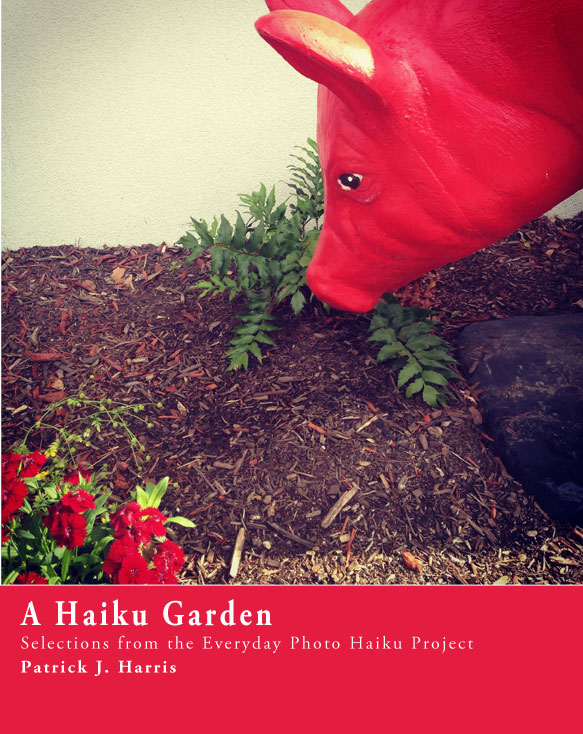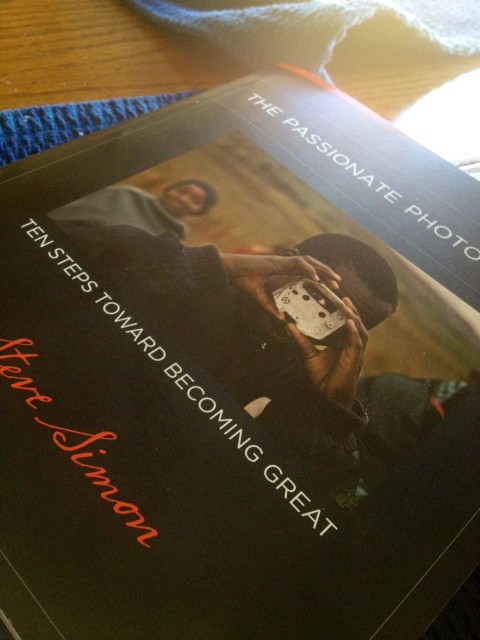Five years ago, the onset of Covid cracked a schism in time. CNN goes long, detailing stories of iconic photos from those early days.
Tag: photography
-
Wikiportraits
“ No professional photographers ever have their photos on Wikipedia, because they want to make money from the photos,” said Jay Dixit, a writing professor and amateur Wikipedia photographer. “It’s actually the norm that most celebrities have poor photos on Wikipedia, if they have photos at all. It’s just some civilian at an airport being like, ‘Oh my god, it’s Pete Davidson,’ click with an iPhone.”
Dixit is part of a team of volunteer photographers, called WikiPortraits, that’s trying to fix that problem.
-
A Haiku Garden – Published!
A Haiku Garden: Selections from the Everyday Photo Haiku Project is published on Amazon!
I created the book, which contains 104 of the most interesting photo haiku from the project. All photos and haiku done on an iPhone (4s then 6).
-
Book review: The Passionate Photographer by Steve Simon
Steve Simon’s book, [amazon_link id=”0321719891″ target=”_blank” ]The Passionate Photographer[/amazon_link], covers photography as more than a hobby. Â Broken into 10 chapters, he goes from identifying one’s desire to take photographs to using that desire to share a vision. In between, basic technical issues are discussed related to gear, f-stops, shutter speed and ISO as well as elementary composition techniques.
Throughout, he intersperses stories and quotes from other photographers, both historical and contemporary. While some photo books only use the authors images, Simon uses others’ images to illustrate points. Each chapter has an assignment for the reader to attempt and how to assess their ability. Â Also, Simon uses personal stories to cap each chapter in a “lesson learned”.
For beginners, Chapter 2, about practice and persistence, and Chapter 3, about ways to keep seeing the world anew will offer the best value. Chapter 6, about how to see light, really shows how to “see” an image–light and contrast creating interesting shapes and forms that are engaging and pleasing to the eye. Chapter 9, details how to go about creating a photo project and executing it, may help all those with ideas of “this would be a cool thing to do…”
[amazon_link id=”0321719891″ target=”_blank” ]The Passionate Photographer[/amazon_link]Â is a well sourced and well written book. Â Colorful, practical and engaging.
-
Review: Creative Black & White Photography by Harold Davis
[easyazon-image-link asin=”0470597755″ alt=”Creative Black and White: Digital Photography Tips and Techniques” src=”http://ecx.images-amazon.com/images/I/41%2BUp%2BR-BSL._SL160_.jpg” align=”left” width=”128″ height=”160″] [easyazon-link asin=”0470597755″]Creative Black and White: Digital Photography Tips and Techniques[/easyazon-link] by Harold Davis is an excellent starting point for beginning photographers or a good reference for advanced photographers looking to learn new techniques.
Most valuable to beginners is the first section, The Monochromatic Vision. Davis clearly and concisely discusses basic photographic concepts to make a good picture. These concepts extend well beyond black and white pictures. He gives examples and considerations to take into account for each concept. Also, photographs are provided to illustrate the concept with a detailed caption of how the photo applies and technical information about it, as well.
The second section, Black and White in the Digital Era, introduces the tools and basic processing techniques for black and white photos. The tools are Adobe-centric, detailing Adobe Camera Raw conversion, Lightroom and Photoshop. These processing techniques can be found in other tools, only implemented differently. Davis emphasizes the power of RAW files and how best to work with them to get black and white images that have contrast, tones and impact.
The third section, Creative Black and White Opportunities, builds on the previous section to provide steps for effects and tricks like sepia coloring, duotones, soft focus and more. This is where Davis really shows the art in the process of processing an image. There are numerous ways to go, and it depends on the photo to create the desired effect.
-
Photo proof you don’t get it right the first time
Below shows that the best shot isn’t the first one you take. Iteratively and progressively, you build on what worked, and use your knowledge to make it better. Also, stuff happens in post-processing of images. As an aside, I prefer to shoot in aperture priority mode to control my depth of field, and I’ll comment on settings for folks, if they’re into that sort of thing.
This is with a bare flash (Vivitar 285HV wide zoom, 1/16th power and camera at f 8, aperture priority). The flash is too bright, nuking the army dude with light. Need to soften the light a bit.

A few shots later, I put a Wescott mini-Apollo softbox over the flash. The softbox is about 10″x6″ and fits on the head of the flash well. The light is softer and direct, but the image needs something more than an army guy on a table.

They defend stuff, right? So I grabbed the salt and pepper shakers, letting the title of “defending the shakers” float in my mind. Ok, it’s somewhat interesting, but white light seems a bit much.
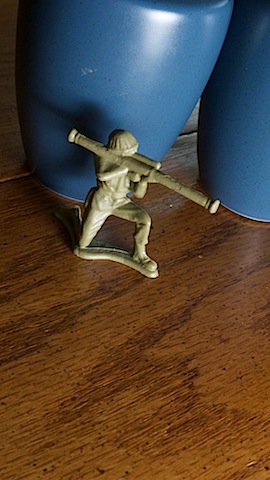
I took the softbox off the flash and added a warming gel and reattached the softbox. I really like this…
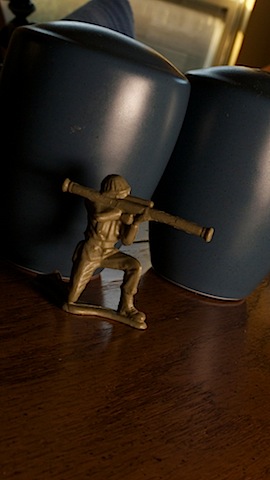
…and let’s punch it up a bit in post-processing, changing the levels, tweaking the curves and upping the saturation.
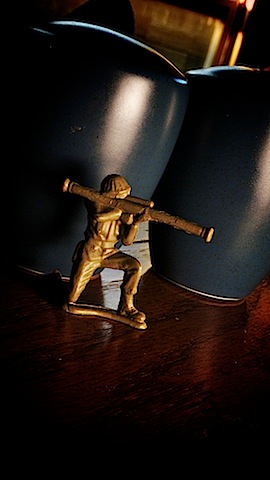
Continuing on, I added a machine gunner buddy. Cool, but what if I added some light behind them?
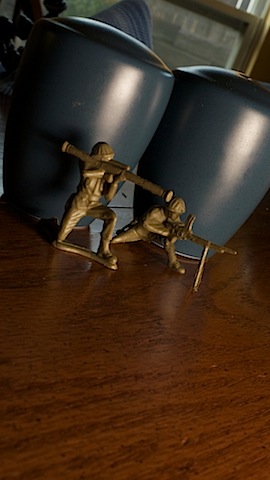
I placed a LumoPro 160 (1/8th power, zoomed to 85mm, placed a foot from the army guys). I should have known it would have been too hard (it’s like a flash grenade went off).
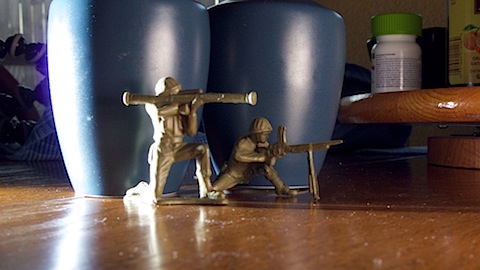
I moved the LumoPro to a counter top, so now that flash is about 6 feet away with the Vivitar still sitting pretty. Like earlier, the white light isn’t doing it for me.
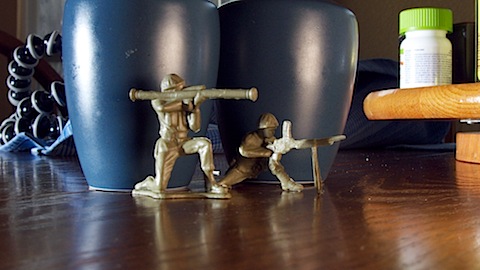
I placed a warming gel on the LumoPro, took a few shots, and this is the one I like. Sharp and warm and with a good angle.
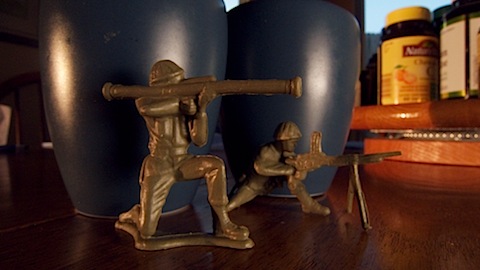
…and now punched up in post-processing like above.
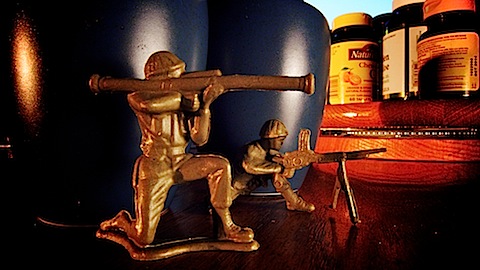
-
Designing a Photograph – Bill Smith
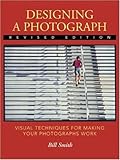
Designing a Photograph: Visual Techniques for Making Your Photographs Work by Bill Smith takes a designer’s view of to a photograph. Visually, what makes something interesting or engaging, and apply it to a photograph. Smith makes the argument of knowing how to pay attention to groups of visuals. These visuals include:
- Figure ground
- selective focus
- similar color
- closure
- continuation
- similar size and shape
- similar texture
- object proximity
The book includes exercises for the reader to perform (shoot in bursts, look at a subject a variety of different ways). Later in the book, Smith details when black and white works better or if color is optimal. Consider contrast and tones and how light affects both.
Images do have f stop and lens information for those curious of technical details.
Designing feels dated, even for 2001, retaining sample images taken with Kodachrome. Kodachrome is dead, and even in 2001 was gasping its final breaths. Ignoring that, applying a designer’s eye to photography can help tremendously with composition and achieving the desired impact.
-
The Tao of Photography –
Tao of Photography: Seeing Beyond Seeing by Philippe L. Gross, S.I. Shapiro applies Zen concepts to photography, interspersed with quotes and anecdotes from photographers that were well known for their visionary approach to what they took pictures of. Each section contains principles, applications of the principles and suggested assignments one can do to apply the principles.
The biggest takeaways from the book are the principles of Great Understanding and Little Understanding. The former refers to the unconscious and receptive nature of self. In photography this applies to composition and feeling of the subject. Little Understanding focuses on the small and immediate, this being tools and equipment available to a photographer. You need both in photography. Often, photographers focus solely on gear and techniques that they forget to seek out something larger in their work.
One way to seek something larger, to filter out unnecessary details, is to constantly discriminate to see the most basic, essential aspects of a photographic vision. Discriminating is not the same as being critical. You actively choose what is needed, not why it’s not needed.
I’d definitely recommend this book to understand a different creative approach. The quotes from famous photographers and personal stories are insightful.
-
Rock Gods – Forty Years of Rock Photography
Rock Gods: Forty Years of Rock Photography by Robert M. Knight is a diverse collection of photos that span his entire career. He’s taken pictures of Jimi Hendrix, Led Zeppelin, Rolling Stones, Jeff Beck and many more.
He focuses on lead guitarists, and his body of work shows that, especially with his live concert shots. Knight excels at the live concert photography. He says his approach is like a journalist or someone doing a documentary, where looking at the photos afterward they come to life in a more visceral way.
In Rock Gods, he tells stories about some of his memorable shoots. Greeting Led Zeppelin in Hawaii as they walk off they plane carrying the master reels to Led Zeppelin II. Meeting Jeff Beck for the first time, after years of trying. And as he’s known for, being the last photographer to shoot Stevie Ray Vaughn.
After paging through the book, I wanted more. More of his old concert shots, more of his more recent work. For photographers, viewing Knight’s work can tell a lot about composition and lighting–what worked, what moment created that visceral feeling you get from a concert photo.
-
Digital Masters by Nancy Brown
Digital Masters: People Photography: Capturing Lifestyle for Art & Stock (A Lark Photography Book) by Nancy Brown is perfect for the Mom With A Camera crowd, who own a digital SLR and want to get into the portrait business. The tone of the book isn’t overly technical, and what technical aspects are mentioned are basic so that one can have a working understanding of equipment. Her tip of having a reflector for outdoor, sunny portraits will help a lot of people. For the most part, she focuses on the process and how to approach the shoots. The sample shots look like stock photos (which is one area she specializes in) of children or people in their 50s, 60s or 70s.
